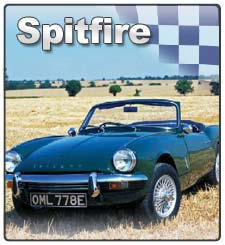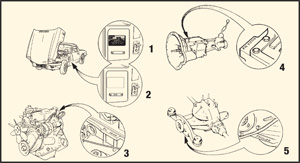Triumph Spitfire Vehicle Information
 Production Data
Production Data
When the very first Spitfire was produced in October 1962 it was called (and badged) the 'Spitfire 4'. In December 1964 it was superseded by the 'Spitfire 4 Mk2'.
In January 1967 a new model, the Mk3 was announced. The Mk3 was produced until Nov/Dec 1970 when it was eventually replaced by the MkIV, which in turn was replaced by the 'Spitfire 1500' in November 1974.
All Spitfire models were produced at the factory in Canley.
To minimise any possible confusion between the 'Spitfire 4', 'Spitfire 4 Mk2' and the MkIV, and to help ensure you order/receive the correct parts, we have used the following model identification system throughout. Spitfire:
Mk1 (Originally badged Spitfire 4),
Mk2 (Originally badged Spitfire 4 Mk2),
Mk3,
MkIV,
1500.
Vehicle Specifications
| Spitfire Mk1 |
| UK Specification Vehicles |
Period of Manufacture |
October 1962 to December 1964
|
| |
Total Cars Produced |
45,753 |
| |
Commission Number Prefixes |
FC |
| |
Commission Numbers Allocated |
FC1 to FC45,753 |
| |
Engine Number Prefixes |
FC |
| Body Dimensions & Weight |
Length |
145" (3,683mm) |
| |
Width |
57" (1,448mm) |
| |
Dry Weight |
1,543lb (700kg) |
| Performance |
Engine Capacity |
1147cc |
| |
Brake Horse Power (@ 5,720rpm) |
63Bhp |
| |
Top Speed |
92mph (148kph) |
| |
0 - 60 mph |
15.5 seconds |
| |
Standing 1/4 Mile |
19.5 seconds |
| Spitfire Mk2 |
| UK Specification Vehicles |
Period of Manufacture |
December 1964 to January 1967
|
| |
Total Cars Produced |
37,409 |
| |
Commission Number Prefixes |
FC |
| |
Commission Numbers Allocated |
FC50,001 to FC88,904 |
| |
Engine Number Prefixes |
FC |
| Body Dimensions & Weight |
Length |
145" (3,683mm) |
| |
Width |
57" (1,448mm) |
| |
Dry Weight |
1,543lb (700kg) |
| Performance |
Engine Capacity |
1147cc |
| |
Brake Horse Power (@ 6,000rpm) |
67Bhp |
| |
Top Speed |
94mph (151km/h) |
| |
0 - 60 mph |
14 seconds |
| |
Standing 1/4 Mile |
19 seconds |
| Spitfire Mk3 |
| UK Specification Vehicles |
Period of Manufacture |
January 1967 to December 1970
|
| |
Total Cars Produced |
65,320 |
| |
Commission Number Prefixes |
FD USA models used FDU |
| |
Commission Numbers Allocated |
FD1 to FD92,803 |
| |
Engine Number Prefixes |
FD |
| Body Dimensions & Weight |
Length |
147" (3,734mm) |
| |
Width |
57" (1,448mm) |
| |
Dry Weight |
1,570lb (712kg) |
| Performance |
Engine Capacity |
1296cc |
| |
Brake Horse Power (@ 6,000rpm) |
75Bhp |
| |
Top Speed |
95mph (153km/h) |
| |
0 - 60 mph |
12.5 seconds |
| |
Standing 1/4 Mile |
18.5 seconds |
| Spitfire MkIV |
| UK Specification Vehicles |
Period of Manufacture |
November 1970 to January 1974
|
| |
Total Cars Produced |
70,021 |
| |
Commission Number Prefixes |
FH USA models used FK |
| |
Commission Numbers Allocated |
FH3 to FH64,995 |
| |
Engine Number Prefixes |
FH |
| Body Dimensions & Weight |
Length |
149" (3,785mm) |
| |
Width |
58 1/2" (1,486mm) |
| |
Dry Weight |
1,638lb (743kg) |
| Performance |
Engine Capacity |
1296cc |
| |
Brake Horse Power to FH25,000 (@ 6,000rpm) |
63Bhp |
| |
Brake Horse Power from FH25,000 (@ 5,500rpm) |
61Bhp |
| |
Top Speed to FH25,000 |
97mph (156km/h) |
| |
Top Speed from FH25,000 |
95mph (153km/h) |
| |
0 - 60 mph to FH25,000 |
12.5 seconds |
| |
0 - 60 mph from FH25,000 |
14.5 seconds |
| |
Standing 1/4 Mile |
19 seconds |
| Spitfire 1500 |
| UK Specification Vehicles |
Period of Manufacture |
November 1974 to August 1980
|
| |
Total Cars Produced |
95,829 |
| |
Commission Number Prefixes |
FH (Issued to September 1979) |
| |
Commission Numbers Allocated |
FH75,001 to FH130,001 |
| |
VIN Prefixes (Vehicle Identification Numbers) (Issued from October 1979 for 1980 models |
TFADW-AT |
| |
VIN Numbers Allocated (With 8 digit prefix as above) |
000,001 to 009898 |
| |
Engine Number Prefixes (All) |
FM |
| Body Dimensions & Weight |
Length |
149" (3,785mm) |
| |
Width |
58 1/2" (1,485mm) |
| |
Dry Weight |
1,682lb (763kg) |
| Performance |
Engine Capacity |
1493cc |
| |
Brake Horse Power (@ 5,500rpm) |
71Bhp |
| |
Top Speed |
101mph (162.5km/h) |
| |
0 - 60 mph |
11.3 seconds |
| |
Standing 1/4 Mile |
18.8 seconds |
Location of Commission Numbers
The following illustration shows where various identification/serial numbers are located on the Spitfire. Although the illustrations depicts the Spitfire 1500, they apply to all models.

1. Commission Number or VIN Number (Late 1500's were allocated VIN - Vehicle Identification Number).
2. Body Number.
3. Engine Number.
4. Gearbox Number.
5. Differential Number.
Service Information
| |
Mk1 |
Mk2 |
Mk3 |
MkIV |
1500 |
| Original Engine Settings |
| Engine Capacity |
1147cc |
1147cc |
1296cc |
1296c |
1493cc |
| Firing Order |
1-3-4-2 |
1-3-4-2 |
1-3-4-2 |
1-3-4-2 |
1-3-4-2 |
| Spark Plug Gap |
0.025" |
0.025" |
0.025" |
0.025" |
0.025"" |
| Contact Breaker Gap |
0.020" Delco Remy |
0.020" Delco Remy |
0.015" Delco Remy |
0.016" Delco Remy |
0.015" Lucas |
| Dwell Angle |
36° |
36° |
40° - 42° |
38° - 40° |
38° - 40° |
| Ignition Timing (static) |
13° BTDC |
13° BTDC |
6° BTDC |
6° BTDC To FH25000
8° BTDC From FH25001
|
10° BTDC |
| Valve Clearance (cold) Inlet & Exhaust Valve |
0.010" |
0.010" |
0.010" |
0.010" |
0.010" |
| Idle Speed (rpm) |
700 - 750 |
700 - 750 |
700 - 750 |
700 - 750 |
750 |
| Idle Mixture (%CO) |
2.5 - 4.5% |
2.5 - 4.5% |
2.5 - 4.5% |
2.5 - 4.5% |
2.5 - 4.5% |
| Capacities |
Cooling System (inc heater)
Standard Radiator |
9 1/2 Pints 5.6 Litres |
9 1/2 Pints 5.6 Litres |
8 Pints 4.7 Litres |
8 Pints 4.7 Litres |
8 Pints 4.7 Litres |
| Engine & Oil Sump (inc filter) |
7 Pints 4.1 Litres |
7 Pints 4.1 Litres |
8 Pints 4.7 Litres |
8 Pints 4.7 Litres |
8 Pints 4.7 Litres |
| Gearbox Only |
1 1/2 Pints 0.9 Litres |
1 1/2 Pints 0.9 Litres |
1 1/2 Pints 0.9 Litres |
1 1/2 Pints 0.9 Litres |
1 1/2 Pints 0.9 Litres |
| Gearbox & Overdrive Unit |
2 3/8 Pints
1.4 Litres
'D' type O/D |
2 3/8 Pints
1.4 Litres
'D' type O/D |
2 3/8 Pints
1.4 Litres
'D' type O/D |
2 1/2 Pints
1.5 Litres
'D' & 'J' type O/D |
2 7/8 Pints
1.6 Litres
'J' type O/D |
| Differential |
1 Pint 0.6 Litres |
1 Pint 0.6 Litres |
1 Pint 0.6 Litres |
1 Pint 0.6 Litres |
1 Pint 0.6 Litres |
| Tyre Pressures (Original/Standard 13" Wheels & Tyres) |
| Front PSI (cold) |
18lb Cross Ply |
18lb Cross Ply
21lb
Optional Radial |
18lb Cross Ply
21lb
Optional Radial |
21lb Cross Ply
21lb
Optional Radial |
21lb Radial |
| Rear PSI (cold) |
24lb Cross Ply |
24lb Cross Ply
26lb
Optional Radial
|
24lb Cross Ply
26lb
Optional Radial
|
26lb Cross Ply
26lb
Optional Radial |
26lb Radial |